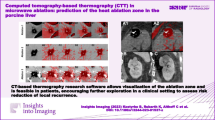Abstract
. Magnetic resonance imaging (MR) is the most sensitive modality for monitoring interstitial thermotherapy (ILT). A real-time pulse sequence that assigns a colour spectrum to grey-scale changes could potentially increase the accuracy of MR-guided thermal surgery. This study aimed to calibrate this sequence with tissue temperature and then to determine whether it could be used to predict accurately the extent of tissue necrosis produced during the formation of a thermal lesion.
Porcine livers were studied within a 0.5T Interventional MR Unit. A Nd:YAG laser fibre (λ=1064 nm) with a diffuser tip was placed within the liver parenchyma adjacent to an MR compatible thermocouple. A template sagittal MR image containing the fibre tip was obtained. A 3 cm region of interest (ROI) was centred on the fibre. Thermal lesions were produced (5 W for 20 min) with real-time subtraction MR monitoring with colour overlay throughout (acquisition time 4 s). At 60 s intervals the pixel intensity value, temperature and colour at the laser tip were noted. Twenty burns were produced. Pixel intensity measurements were expressed as percentages of mean pixel intensity within the ROI to standardise measurements. Using the colour representing the temperature above which tissue necrosis would be expected to occur, predicted maximum lesion size was measured from the images and compared with histological assessment.
There was a linear relationship between temperature and percentage pixel change (r 2= 0.84). Six discrete colours were determined, all significantly different from each other in terms of mean percentage pixel change (p<0.01) and mean temperature (p<0.01 except between orange and yellow, p=0.037). Green had a mean temperature of 55.6 (±5)°C, and thus predicted necrosis. Image-predicted maximum lesion size correlated closely with histology (r 2=0.93).
The colour changes produced by this unique pulse sequence have been calibrated with tissue temperature in vitro. The green colour represents the temperature above which necrosis would be expected to occur and can be used to accurately predict lesion size. This will potentially allow greater accuracy and safety for MR monitoring of ILT in vivo.
Similar content being viewed by others
Author information
Authors and Affiliations
Additional information
Paper received 16 September 1997; accepted after revision 18 March 1999.
Rights and permissions
About this article
Cite this article
Gould, S., Vaughan, N., Gedroyc, W. et al. Monitoring of Interstitial Laser Thermotherapy with Heat-sensitive Colour Subtraction Magnetic Resonance Imaging: Calibration with Absolute Tissue Temperature and Correlation with Predicted Lesion Size. Lasers Med Sci 14, 250–256 (1999). https://doi.org/10.1007/s101030050092
Issue Date:
DOI: https://doi.org/10.1007/s101030050092




